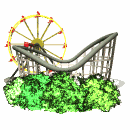Super Loop
CTA is Going in Circles
(Map of Super Loop below)
The Metropolitan West Side Elevated Railway began electrification of the Chicago elevated lines in 1895, and a piece of the original line along Paulina Street is key to the Super Loop recently proposed by CTA. This section now links the CTA Green Line with the point at which the Douglas Park elevated rises and leaves the Eisenhower Expressway Congress Street service. In the distant past it was the line that enabled passengers to transfer from Lake Street elevated trains to the Metropolitan West Side lines that served Logan Square, Humbolt Park, Douglas Park and Garfield Park.
The proposed Super Loop would utilize trackage of the Orange Line from the vicinity of Ashland and Archer Avenue, switch over to the Red Line through the subway under State Street, and then use new trackage taking off at Clyborn and circle around, affording transfer to the Blue Line to O'Hare field at Division Street. It would then serve stations at Ashland and Lake, th new Madison/United Center on the Paulina connector, and then join up with the Douglas Park line for a stop at Van Buren/Medical Center, 18th Street/Paulina, and then at Blue Island Avenue.
Another smaller loop has been proposed that would be strictly in the subway. It would use the south part of the Blue Line to the Loop, where it would run under Dearborn Street. It would continue in the Blue Line portion under Lake Street up to Clinson Street. At that point, a new subway would be built under Clinton Street to link the north and south edges of the Blue Line, forming a Blue Line bi-directional loop that would serve the erstwhile North Western Station/Olgilvie Transportation Center, as well as Union Station.
If the plans reach fruition, the century-old elevated loop would be joined by a new underground, slightly larger loop. The new Super Loop would put the western boundary of center-city looped rapid transit service roughly along Ashland and Paulina Avenues. There is a proposed super-duper-loop that would run along the tracks or right-of-way of the Elgin, Joliet & Eastern; it would link the Metra commuter rail lines that radiate out from downtown Chicago.
Mayor Daley has expressed interest in the Super Loop, which would probably be called the Circle Line; he has indicated that he would provide lobbying muscle to get the funds. The project is expected to cost at least a billion dollars. If the Blue Line subway loop is built, the subway under Clinton Street would be extremely expensive. Such a venture would clearly show Chicago's desire to make major investments in improving life in the downtown part of the city.
Railfan & Railroad, Tony Gura, April 2003, Prof. George M. Smerk Instistute for Urban Transportation, Bloomington, IN
Citizens Taking Action
for advancement of transit and trains www.CTAriders.org


